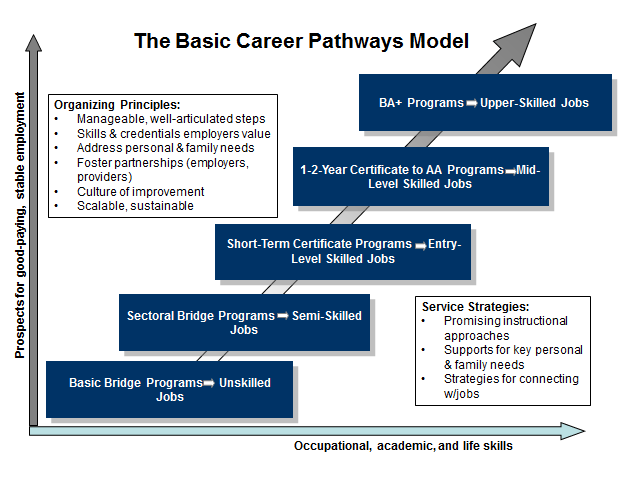Career pathways programs provide post-secondary education and training that is organized as a series of manageable steps leading to successively higher credentials and employment opportunities in growing occupations. Each step is designed to prepare individuals for the next level of employment and education and provide a credential with labor market value. To effectively engage, retain, and facilitate learning of a diverse population, programs integrate promising instructional strategies, supports, and employer connections. The model assumes interventions must be comprehensive and intensive to address effectively the learning and life challenges facing adult students. Mobilizing these inputs typically requires a partnership between providers such as community-based organizations, community colleges and other post-secondary training providers, human services and workforce agencies, and employers and their representatives.
Although steps in actual programs vary with their target populations, focal occupations, and service strategies, the broad training and employment levels are shown in the figure below. The bottom two steps (I and II) represent so-called “on ramp” and “bridge” programs designed to prepare low-skilled participants for college-level training and lower-skilled jobs with a career focus. Basic skill levels differentiating these two levels vary across programs but generally correspond to the 6th-8th grade and 9th-11th grade ranges, respectively. The next two levels (III and IV) provide college-level training for so-called “middle skills” employment—that is jobs requiring some college but less than a bachelor’s degree (e.g., an associate’s degree or shorter certificate)—and the final level (V) includes interventions promoting completion of bachelors’ degrees and more advanced credentials. The career pathways model is designed to allow initial entries, exits, and re-entries at each stage—depending on skill levels and prior training, employment prospects, and changing personal and family situations.

For general information about career pathways approaches, please refer to the Joint Letter On Career Pathways. For more information about the career pathways programs in PACE, visit the Overview of PACE Partner Sites page of this website.

